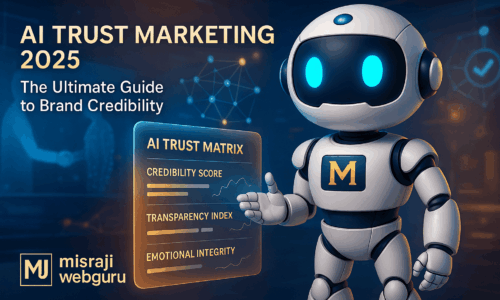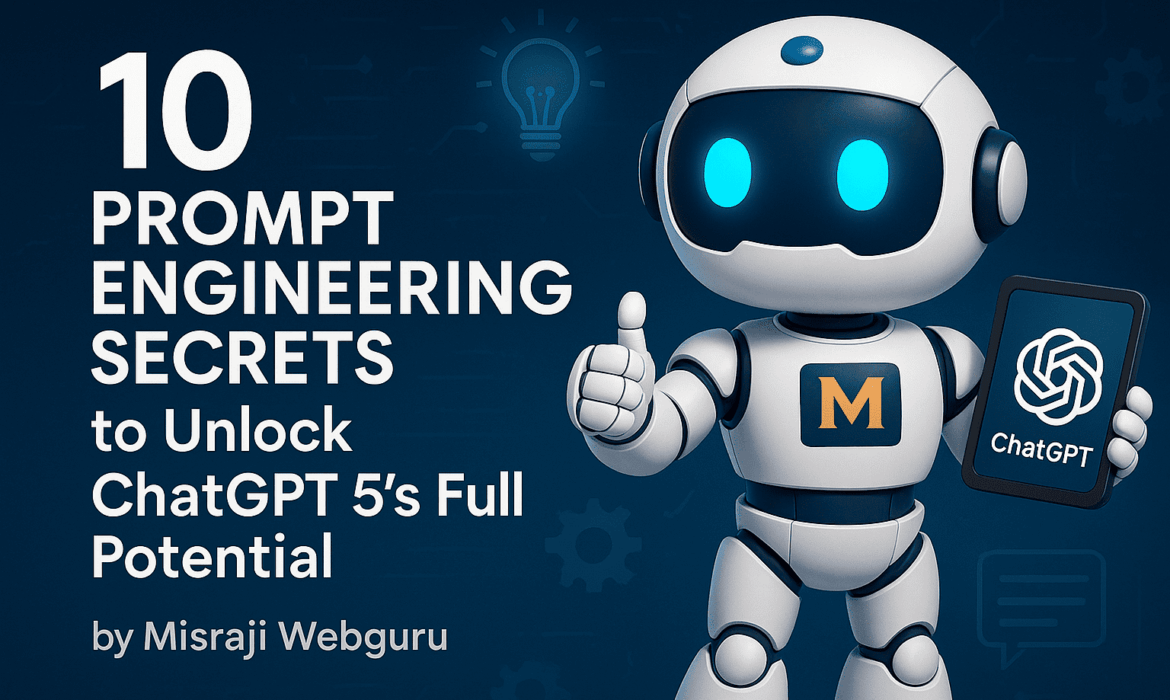
Introduction
Artificial Intelligence is only as good as the instructions we give it. This is why Prompt Engineering has become the cornerstone of modern AI usage. With ChatGPT 5, OpenAI has introduced deeper reasoning, improved contextual memory, and more natural conversations — but to get the best out of it, you need to know how to ask the right questions.
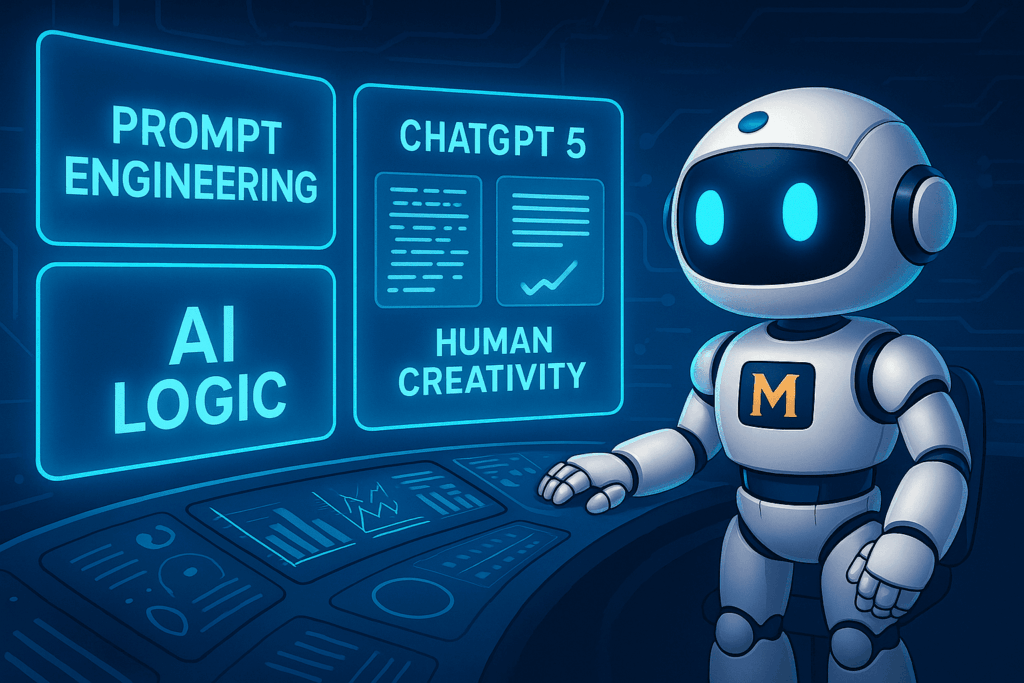
At MisraJiWebGuru, we’ve seen how poor prompts lead to average results, while effective prompt engineering turns ChatGPT 5 into a game-changing partner for businesses, creators, and professionals. This blog reveals 10 powerful Prompt Engineering secrets that will help you learn how to prompt ChatGPT 5 effectively and unlock its full potential in 2025.
What is Prompt Engineering?
Prompt Engineering is the art and science of designing effective inputs (prompts) that guide AI tools like ChatGPT 5 to produce useful, accurate, and high-quality outputs.
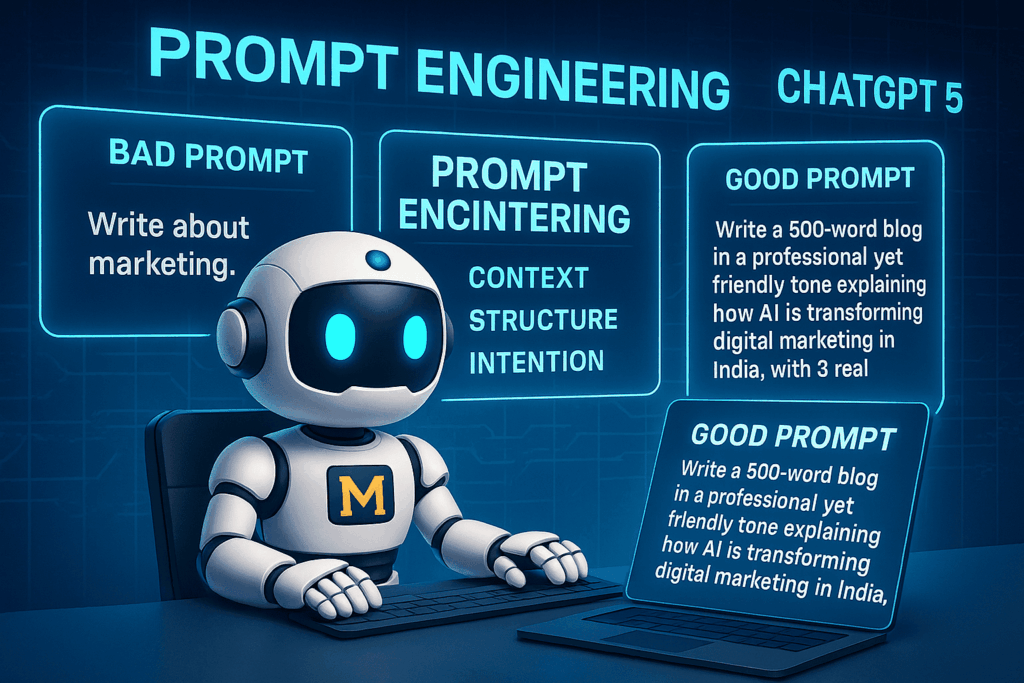
Instead of simply typing a vague question, you frame your request with context, structure, and intention. For example:
- Bad prompt: “Write about marketing.”
- Good prompt: “Write a 500-word blog in a professional yet friendly tone explaining how AI is transforming digital marketing in India, with 3 real examples.”
The second prompt demonstrates prompt engineering because it gives ChatGPT 5 clear boundaries, context, and expected output format.
Prompt Engineering has evolved since GPT-3 and GPT-4, but in ChatGPT 5, it has become even more critical because the model can process longer contexts, perform complex reasoning, and adapt to roles better.
Why Prompt Engineering Matters for ChatGPT 5
ChatGPT 5 is more advanced, but it isn’t magical. Without the right prompt, you may still get vague, repetitive, or incomplete answers. This is where prompt engineering shines:
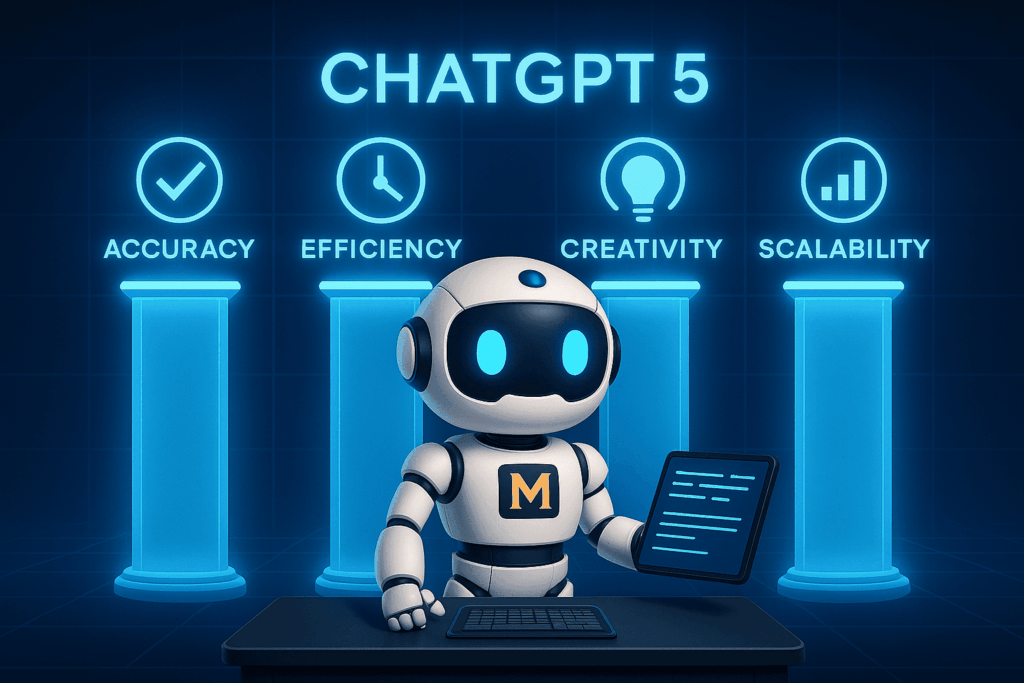
- Accuracy: Well-structured prompts reduce factual errors.
- Efficiency: Saves time by avoiding rework.
- Creativity: Unlocks unique outputs by guiding tone and style.
- Scalability: Businesses can use prompts to automate content, research, and workflows consistently.
Simply put, if you want to learn how to prompt ChatGPT 5 effectively, mastering engineering is non-negotiable.
10 Prompt Engineering Secrets to Unlock ChatGPT 5
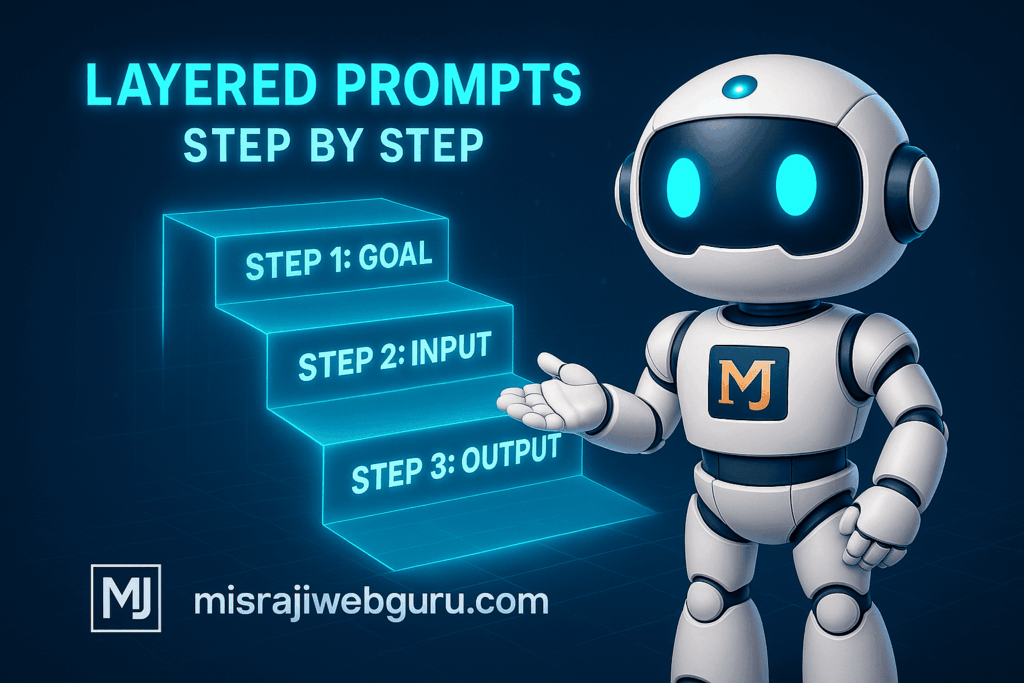
1. Start with Contextual Framing
Always set the stage. Give ChatGPT 5 the who, what, why, and how before asking for an output.
- Example: “You are a social media strategist. Write a LinkedIn post targeting small business owners about AI tools in 2025.”
2. Use Role Assignment
Tell ChatGPT 5 to act as a teacher, coder, marketer, or consultant. This aligns tone and structure.
- Example: “Act as a coding tutor. Explain recursion in Python for beginners.”
3. Layer Instructions Step by Step
Instead of one long prompt, break it into parts. This reduces confusion and improves results.
- Example: “Step 1: Outline a blog. Step 2: Expand each section. Step 3: Add FAQs.”
4. Combine Constraints and Freedom
Balance control and creativity.
- Example: “Write a 300-word blog with a formal tone but add one witty example.”
5. Leverage Examples in Prompts
Show ChatGPT 5 the style you want.
- Example: “Here’s a paragraph I like — match this tone when writing about digital branding.”
6. Ask for Multiple Perspectives
Push ChatGPT 5 to give alternatives.
- Example: “Explain blockchain to a child, a university student, and a business CEO.”
7. Use Iterative Prompting
Treat prompts as conversations, not one-off instructions. Refine with follow-ups.
8. Apply Advanced Formatting Instructions
Ask for tables, bullet points, or frameworks.
- Example: “Summarize this data in a comparison table with pros and cons.”
9. Prompt for Verification and Self-Critique
Make ChatGPT 5 review its own work.
- Example: “Provide the answer, then double-check and highlight possible errors.”
10. Blend AI with Human Creativity
AI works best when combined with human storytelling. At MisraJiWebGuru, we pair AI logic with creative strategy to deliver campaigns that connect with both data and emotions.
How to Prompt ChatGPT 5 Effectively
Here’s a quick checklist:
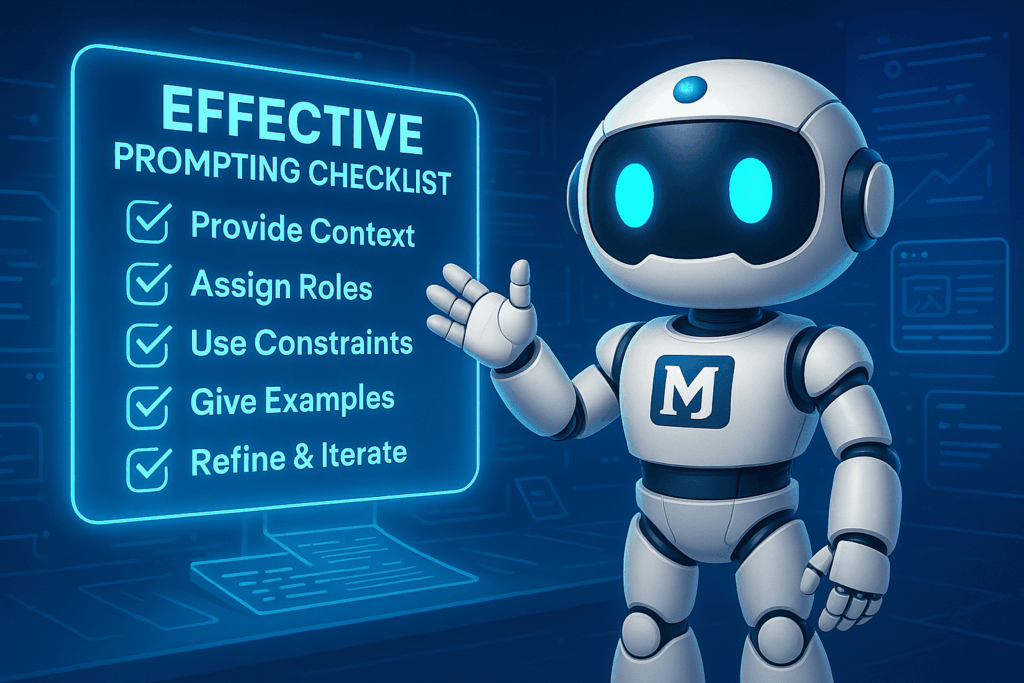
✅ Provide context and background.
✅ Assign roles clearly.
✅ Use constraints (length, tone, format).
✅ Give examples when possible.
✅ Review, refine, and iterate.
Do’s: Be specific, structured, and creative.
Don’ts: Avoid vague instructions, overloading a single prompt, or ignoring iteration.
Master these, and you’ll never wonder how to prompt ChatGPT 5 again.Real-World Applications of Prompt Engineering
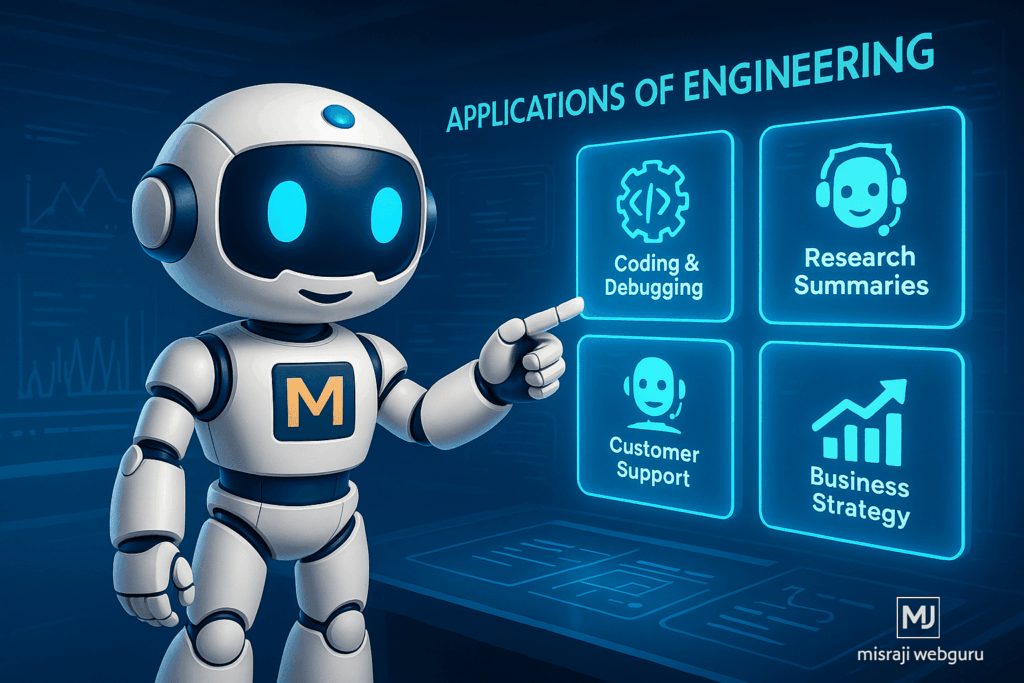
- Content Creation – Blogs, SEO articles, social media posts.
- Coding & Debugging – Writing scripts, finding bugs, improving code efficiency.
- Research Summaries – Academic notes, industry overviews, market insights.
- Customer Support – Automated responses and FAQ systems.
- Business Strategy – Drafting marketing campaigns and workflows.
At MisraJiWebGuru, we’ve implemented these applications for clients across industries, showing how prompt engineering drives real results.
Essential Tools for Prompt Engineering in 2025
- Prompt Libraries – Collections of reusable prompt templates.
- LangChain – Framework for building advanced AI workflows.
- OpenAI Playground – Testing and refining prompts.
- Browser Extensions – Tools like AIPRM or FlowGPT.
- AI-Enhanced Editors – For refining tone, grammar, and structure.
These tools combined with prompt engineering make your interaction with ChatGPT 5 smarter and scalable.
10 Ready-to-Use Prompts for SEO-Friendly Blog, Article & Guest Post Writing
If you want to create content that ranks, engages, and converts, the right prompt can make all the difference. Below are 10 SEO-optimized prompts designed to help you write blogs, articles, and guest posts that perform well in search engines.
1. SEO Article Prompt
“Write a 1500-word SEO-optimized article on [Primary Keyword]. Use [Secondary Keyword] naturally, include an engaging introduction, subheadings with H2 and H3 tags, FAQs, and a conclusion with a strong CTA. Maintain keyword density between 1–1.5%.”
2. Blog Prompt (Educational Style)
“Create a 2000-word educational blog on [Primary Keyword]. Keep the tone friendly yet professional. Add actionable tips, step-by-step guides, case studies, and at least 5 internal links. Optimize meta title, description, and headings for Rank Math 100/100.”
3. Guest Blog Prompt (Authority Building)
“Draft a 1200-word guest blog for [Target Website/Industry] on [Primary Keyword]. Provide value-driven insights, reference credible data, and include 3–4 external authoritative links. End with a strong bio section linking back to [Your Website].”
4. How-To Article Prompt
“Write a detailed how-to article on [Primary Keyword] in 1800 words. Use numbered steps, practical examples, and schema-ready FAQs. Naturally integrate [Secondary Keyword] throughout the article.”
5. Listicle Blog Prompt
“Draft a 2500-word listicle blog titled ‘Top 10 [Keyword] Strategies in 2025.’ Each point should explain the strategy, its benefits, and real-world examples. Conclude with a summary and CTA. Maintain keyword density around 1%.”
6. Guest Blog Prompt (Thought Leadership)
“Write a 1500-word thought-leadership guest post on [Primary Keyword] tailored for [Industry Audience]. Use an authoritative and visionary tone. Highlight trends, research data, and unique insights to build brand credibility.”
7. Case Study Article Prompt
“Create a 1600-word case study article on [Keyword Topic]. Present real-world examples, challenges, solutions, and measurable outcomes. Use storytelling to make it engaging while including [Primary Keyword] and [Secondary Keyword].”
8. Beginner’s Guide Blog Prompt
“Write a beginner’s guide blog on [Primary Keyword] in 2200 words. Define key terms, list pros & cons, and provide examples. Add schema-ready FAQs and optimize for readability with short sentences and bullet points.”
9. Problem-Solution Guest Blog Prompt
“Draft a 1500-word guest blog for [Target Industry] on [Primary Keyword]. Start with the problem, provide actionable solutions, and back your insights with statistics. Naturally integrate [Secondary Keyword] for SEO relevance.”
10. Trend Report Article Prompt
“Write a 2000-word research-based article on [Primary Keyword Trends in 2025]. Include expert quotes, fresh statistics, and future predictions. Apply SEO best practices: meta tags, keyword density, schema, and internal/external links.”
With these 10 plug-and-play prompts, you’ll never struggle with structuring SEO-friendly content again. Whether it’s a blog, article, or guest post, these prompts ensure your writing is optimized to rank higher and engage readers effectively.
10 Prompts for Marketing Content Creation
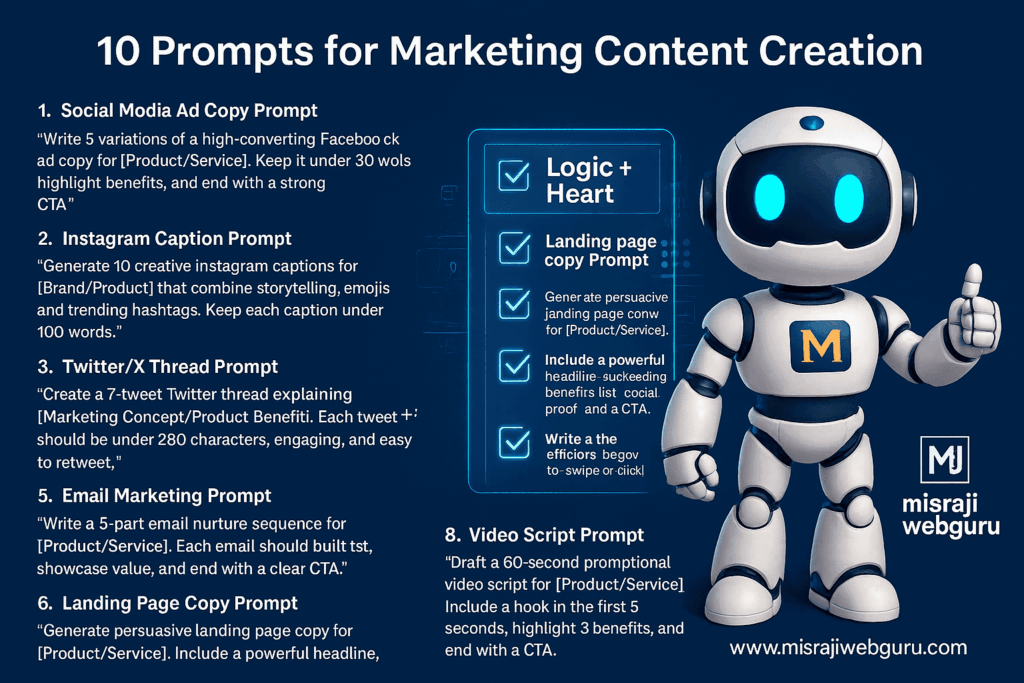
1. Social Media Ad Copy Prompt
“Write 5 variations of a high-converting Facebook ad copy for [Product/Service]. Keep it under 30 words, highlight benefits, and end with a strong CTA.”
2. Instagram Caption Prompt
“Generate 10 creative Instagram captions for [Brand/Product] that combine storytelling, emojis, and trending hashtags. Keep each caption under 100 words.”
3. LinkedIn Post Prompt
“Write a 250-word LinkedIn post targeted at [Industry Audience]. Share insights about [Topic] and position the brand as a thought leader. End with a question to encourage engagement.”
4. Twitter/X Thread Prompt
“Create a 7-tweet Twitter thread explaining [Marketing Concept/Product Benefit]. Each tweet should be under 280 characters, engaging, and easy to retweet.”
5. Email Marketing Prompt
“Write a 5-part email nurture sequence for [Product/Service]. Each email should build trust, showcase value, and end with a clear CTA.”
6. Landing Page Copy Prompt
“Generate persuasive landing page copy for [Product/Service]. Include a powerful headline, subheading, benefits list, social proof, and a CTA button.”
7. Brand Storytelling Prompt
“Write a brand story for [Company Name]. Highlight its mission, values, and customer impact in under 500 words with an emotional and relatable tone.”
8. Video Script Prompt
“Draft a 60-second promotional video script for [Product/Service]. Include a hook in the first 5 seconds, highlight 3 benefits, and end with a CTA.”
9. Influencer Collab Prompt
“Write an Instagram collaboration script for an influencer promoting [Product/Service]. Keep it authentic, engaging, and relatable to Gen Z and Millennials.”
10. Carousel/Ad Creative Prompt
“Create a 5-slide carousel copy for LinkedIn or Instagram promoting [Topic/Product]. Each slide should include a headline, supporting text, and a call to swipe or click.”
With these prompts, you can generate consistent, high-impact marketing content across platforms — from ads to social posts to storytelling campaigns.
FAQs on Prompt Engineering and ChatGPT 5
1. What is Prompt Engineering in ChatGPT 5?
Prompt Engineering is the practice of crafting clear, structured prompts that guide ChatGPT 5 to deliver accurate and useful outputs.
2. Why is Prompt Engineering important for ChatGPT 5?
Because GPT-5 is highly advanced, the right prompt ensures efficiency, accuracy, and creativity in responses.
3. How do I learn Prompt Engineering quickly?
Start with examples, practice role-based prompts, and refine outputs iteratively.
4. What are the best practices for 2025?
Context, role assignment, structure, iteration, and verification.
5. How does Prompt improve ChatGPT 5 accuracy?
It reduces ambiguity, narrows focus, and improves logical flow in AI outputs.
6. What are examples of advanced Prompt techniques?
Few-shot prompting, chain-of-thought prompting, and iterative refinement.
7. How can small businesses use Prompt with ChatGPT 5?
To generate marketing content, customer FAQs, and strategy ideas affordably.
8. Is Engineering different from normal prompting?
Yes. Prompt Engineering is intentional, structured, and optimized for results.
9. What are the most common mistakes in Prompt Engineering?
Being too vague, overloading instructions, or failing to iterate.
10. How does MisraJiWebGuru help with Prompt Engineering for businesses?
We design AI workflows, create prompt libraries, and train teams for effective use.
11. Can Prompt Engineering be applied in AI content writing?
Yes. It ensures blogs, ads, and posts are SEO-friendly and aligned with brand tone.
12. How do I prompt ChatGPT 5 for coding tasks?
Assign it the role of a coder, specify language, and request examples with explanations.
13. What tools support Prompt Engineering in 2025?
LangChain, OpenAI Playground, FlowGPT, and curated prompt libraries.
14. What industries benefit most from Prompt Engineering?
Marketing, education, research, healthcare, customer service, and IT.
15. How do I start Prompt Engineering with ChatGPT 5 today?
Begin by practicing structured prompts and learning from guides like this one at MisraJiWebGuru.
Final Thoughts – Master Prompt Engineering with MisraJiWebGuru
Prompt Engineering is no longer a niche skill — it’s the foundation of AI success in 2025. By applying the 10 secrets shared above, you can transform the way you work with ChatGPT 5.
At MisraJiWebGuru, we believe in blending logic (AI, analytics, structure) with heart (creativity, emotion, storytelling). That’s how we help businesses and individuals scale with confidence.
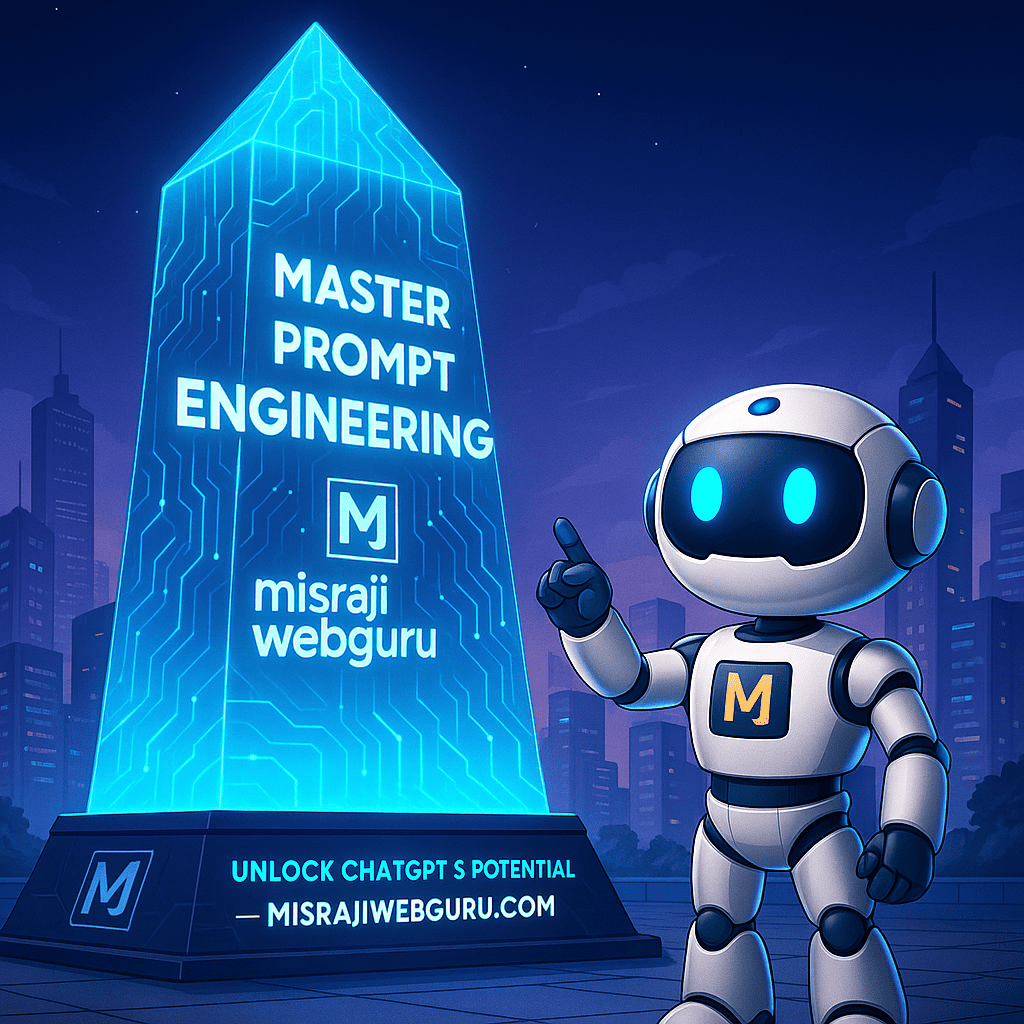
👉 Ready to unlock the full potential of ChatGPT 5? Contact MisraJiWebGuru today and let’s build your next big success with smart prompt engineering.

